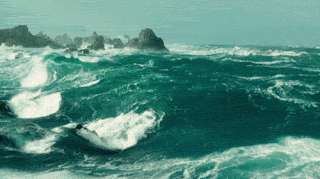What is the hydrosphere?
When the first astronauts went into space they saw that the Earth was blue. This is because three quarters of the surface is covered with water from the oceans.
The hydrosphere is one of the layers of the Earth. It is made up of all the water on Earth.
Most of the water of the hydrosphere is salt water. 97% is water from the seas and oceans.
Salt water is found in seas and oceans.
Fresh water
Fresh water comes from rivers, lakes and groundwater, although most of the fresh water on Earth is ice from glaciers, snow on the mountains and from the poles.
Only 3% of all the water on Earth is fresh water, the water we can drink.
Surface water and groundwater
There are two types of fresh water on Earth:
Surface water: This is found on the surface of the Earth, in rivers and lakes and as ice in glaciers.
Groundwater: is water that is deposited under the ground. It collects from rain that falls through the soil. This water can form aquifers and underground rivers.Rivers
A river is a body of water in continuous movement that flows to the sea.
The main parts of a river are: the course, the channel and the flow regime.
Course. The route the river takes. It has three parts:1.- Upper course. The land is steep next to the source.
2.- Middle course. The land is flatter and the river is wider.
3.- Lower course. This is the very flat land near the mouth of the river.
River basin.
This is an area
of land
drained by a
river and its
tributaries.
Channel. This is the area that
contains the flowing water of
the river.
Flow regime.
The flow regime is the amount of water the river carries. It can vary depending on the time of the year.River Model
The water cycle
Water is always moving around the Earth. We call this movement the water cycle. The water cycle takes place between the atmosphere and the Earth’s crust.
1. Evaporation: The Sun heats liquid water. It evaporates to form water vapour in the air.
2. Condensation: The water vapour passes into the cold air in the troposphere. Here, it condenses into tiny water droplets and forms clouds.3. Precipitation: The tiny water droplets form larger, heavier drops. These droplets fall from the clouds as rain or snow onto the Earth’s crust.
4. Collection: Water in the rivers goes into the seas and oceans. The cycle starts again.
SongThe rivers of Spain
In Spain there are different types of rivers because they flow through different types of relief and climate.
Relief influences the length of rivers. Rivers are long if their source is in the mountains far from the sea. Rivers are short if their source is near the sea.
Climate influences the flow regime. Rivers that flow through rainy areas have abundant flow regimes. Rivers that flow through dry areas have low flow regimes.
Watersheds in Spain
A watershed is an area of land where all the main rivers flow into the same sea.
The three main watersheds in Spain are the Cantabrian, the Atlantic and the Mediterranean watersheds.
1 The Cantabrian watershed is in the north of Spain. It is the smallest watershed. All the rivers flow into the Cantabrian Sea.
The main rivers are the Navia, the Nalón and the Eo.
2.-The Atlantic watershed is the largest in Spain. All the rivers flow into the Atlantic Ocean.
The rivers have these characteristics: The rivers that flow across the Iberian Peninsula, for example, the Tajo, are long because they start in mountains far from the sea. They have a higher flow regime in spring and autumn than in summer.
In the Canary Islands there are no rivers, only gullies. Gullies are channels that carry water only when it rains.
The main rivers are:
The Miño: Its source is in the Galician Massif. Its main tributary is the Sil.
The Duero: Its source is in the Iberian Mountain Chain. Its main tributaries are the Pisuerga, the Elsa and the Tormes.
The Tajo: Its source is in the Iberian Mountain Chain. Its main tributaries are the Jarama and the Alagón.
The Guadiana: Its source is on the plains of La Mancha. Its main tributaries are the Cigüela and the Zújar.
The Guadalquivir: Its source is in the Subbetic Range. Its main tributary is the Genil.
3.-The Mediterranean watershed
Most of the rivers have these characteristics: They are short because they start in mountains near the sea. They flow through areas of little rain, so they have a low flow regime. In some places the climate is so dry that there are only gullies. The main rivers are the Júcar, the Segura and the Ebro.
1.-The Ebro is the longest river in the Mediterranean watershed. Its source is in the Cantabrian Range. Its upper course flows through areas where it rains and snows a lot. For this reason it has the most abundant flow regime in Spain. The main tributaries of the Ebro are the Segre and the Jalón.
http://mibauldeclase-cbc.blogspot.com/2017/11/los-rios-y-vertientes-de-espana.html?spref=pi















